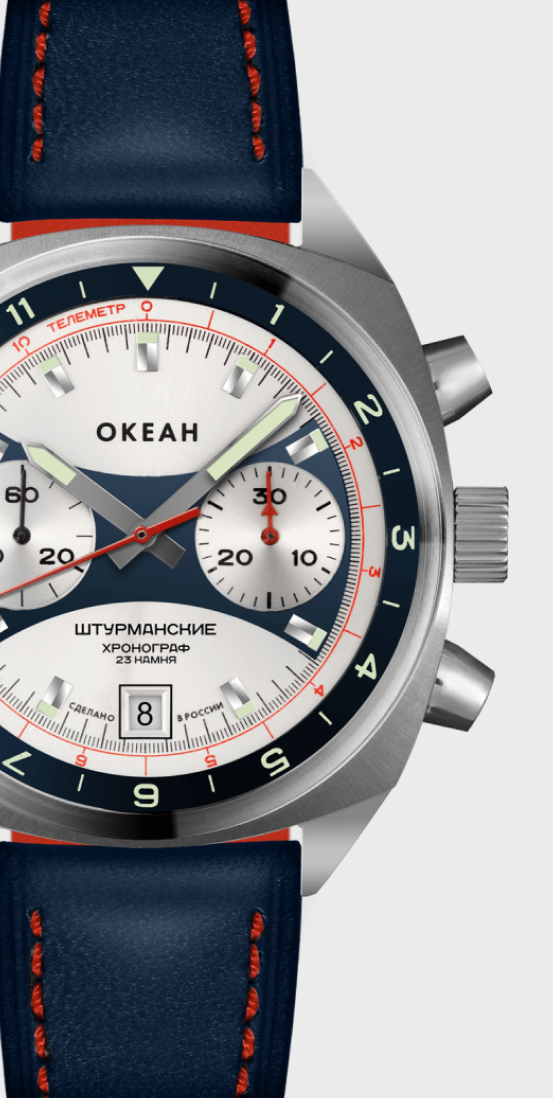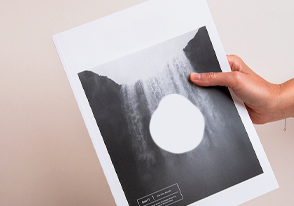OCEAN OF TIME: STORY OF WATCH DESIGNED FOR NAVAL OFFICERS
In the late 20th century, the 1st Moscow Watch Factory produced a lot of noteworthy watches for both general consumption and special purposes. The Okean chronograph was one of the most promising and multi-functional models made for naval officers.
Watches for navy
The Okean was the second non-customized Soviet chronograph after the Strela, which began to be made by the 1st Moscow Watch Factory as early as in 1959. The Okean production was launched in 1976. The watch used to pass the state quality control and was not generally available; therefore, it was especially valuable and is still the most wanted target of collectors in Russia and abroad.
The Okean was unavailable in stores, and even not all naval officers could buy it. It is known that Sergei Gorshkov, the Commander-in-Chief of the USSR Navy, wore such watch from 1956 until 1985. The chronograph was included into the vessel equipment and produced in limited quantities. Eyewitnesses recall that sailors deliberately reported allegedly sunken watch to obtain one for personal use.
Why was the chronograph so unique and attractive? Its three features such as design, functionality, and mechanism ensured the Okean’s success.
Okean outside
The watch in a stainless steel cushion-shaped case looked rather impressive:
The “Captain’s Navy” engraving on the rear case of the Okean chronograph expressly indicated who the watch was intended for:
However, some watch owners ordered clean rear covers to put a customized inscription thereon and replace the regular one, with such specimens found in modern collections.
An alternating luminous mass was applied to the hands and signs of the dial so that the watch could be used in darkness and the Okean’s case was made waterproof.
Now let us tell you about the chronograph features in addition to the standard reading of hours, minutes and seconds, and it could do a lot. Its other features included:
- indicated day of the month;
- stopwatch (left side window);
- minute counter for 30 minutes (right side window);
- countdown of standard time within 12 time zones (external scale);
- a telemeter for measuring the distance between the owner of the watch and the phenomenon that is first perceived by the sense of sight, and then by the sense of hearing, for example, an explosion or thunder and lightning.
|
Manual of the Okean watch for captains of naval vessels operation.
|
|
The watch is designed for a long-term use at correct operation. The following rules should be observed during operation: - wind up every morning and once a day until full spring charging; - in order to avoid contamination, mechanism deterioration and waterproofness failure, do not open the watchcase; - the watch should not be used when diving; - the watch should not be exposed to rapid change of temperatures, because such change can result in fogging of the glass; - keep the watch away from chemicals; - regularly (every 2-3 years) clean, grease and adjust the watch. To set the hands of the watch on the current time, pull the crown (1) out and rotate it clockwise or counter-clockwise until the current time is set, then push the crown back in.
To set a correct date, pull the crown (1) out and set the hour and minute hands on 1 o’clock, and then move the hands in the opposite direction until you set time at 10 o’clock, then rotate the crown until you set 1 o’clock. The date can now be changed. Having set the date, you should set the current time by rotating the hands clockwise and push the crown back in to complete the process.
|
The watch was wound manually and, when fully wound, had a running time of at least 43 hours with the stopwatch off and 35 hours with the stopwatch on. The average daily rate was from -10 to +20 seconds (at the temperature of 20+/-5°C). Such indicators were ensured by a high-performance mechanism of the watch.
Okean inside
The watchwork of the first Soviet Strela chronograph number 3017 became obsolete by the beginning of the 1970s, so the new watch generation needed renovation.
The Okean became the first Soviet watch equipped with the most reliable and still highly demanded mechanism number 3133, also known to connoisseurs as Poljot 3133 (since the products of the 1st Moscow Watch Factory were produced under the Poljot brand name from 1964), perhaps the most famous Russian watch caliber in the world. The story behind it is as follows.
Several years before, the Soviet Union acquired the rights to Swiss Valjoux 7734 mechanism, a descendant of another Swiss Venus 188, which was produced until mid-1960s.
However, the designers of the 1st Moscow Watch Factory of the USSR both adapted the existing caliber to Soviet models and significantly improved it. Experts around the world recognize that the mechanism has become more accurate, more reliable, and easier to repair and maintain.
Modernization can be tracked by quantitative indicators:
- the frequency of semi-oscillations was increased from 18,000 to 21,600 per hour;
- the number of ruby stones was increased from 17 to 23 pieces.
The duration of stroke was increased, and the mechanism impact protection was enhanced. It is no coincidence that the USSR State Prize was awarded to the plant designer team for the work.
This is what the prototype and modern result look like (with Valjoux 7734 on the left and Flight 3133 on the right):
By 1974, the Soviet mechanism was ready and indicated with number 3133, and two years later it became the “heart” of the navy chronograph.
The life of the famous mechanism in the watch industry was just beginning. Next year, the First Moscow Watch Factory launched the Sturmanskie watch also in limited series for Air Force officers. This watch also operated with 3133 but had some modification, the stop-second function. The modification got number 31659.
In 1983, the watch with 3133 mechanism finally became generally available after the First Moscow Watch Factory launched production of the Poljot watch and its export version. Contemporaries remember that the cost of the watch was about 130 rubles and a lot of people dreamed of getting such.
As for the Okean, it has never been on the open market, therefore very few samples of this unique Soviet watch remained to date ...
The Okean today
In view of very limited target output and the conditions which the watch was used under, it is very difficult to find a functioning exclusive copy of the watch from the USSR.
However, it cannot prevent those wishing to wear an authentic Okean chronograph. The First Moscow Watch Factory continues to produce the watch under the Sturmanskie trademark!
Since watches of the 1970s had an extremely good features and did not need to be improved, the modern Russian Okean does not differ much from the Soviet model. The dial is designed almost identically, with only the “Sturmanskie Chronograph” and “Made in Russia” inscriptions added:
The watch has carefully preserved its other features, such as the color scheme, geometry, style of the indexes, shape and size of all hands except the second one, which looks more elegant now. The manufactured dial details use modern materials and compositions, so the dial looks sophisticated and is to last long.
The back cover, however, has been designed in a different style to emphasize that any fan of the watch model can now purchase it:
The functionality of the chronograph has remained completely the same, including an exotic telemeter to measure the distance. At the same time, some improvements have been made to the outer shell of the watch:
- the dial is now protected by mineral glass instead of plastic;
- watertight integrity was increased to 5 atm;
- the watch has become a little larger 40 mm instead of 38 mm, which made it more convenient to use.
The legendary Soviet Poljot 3133 mechanism ensures smoothly running, highly reliable, and maintainable watch. The mechanism is not merely used as a tribute to Soviet designers but proves to be the best solution to ensure the high-quality chronograph.
Thus, the Russian Okean chronograph is a wonderful gift to watch collectors and watch lovers who prize a watch for its interesting and storied background, useful functions, and bespoke and tailored design.



































